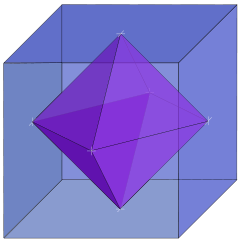Kalai's 3^d conjecture
In geometry, Kalai's 3d conjecture is a conjecture on the polyhedral combinatorics of centrally symmetric polytopes, made by Gil Kalai in 1989.[1] It states that every d-dimensional centrally symmetric polytope has at least 3d nonempty faces (including the polytope itself as a face but not including the empty set).
Examples

In two dimensions, the simplest centrally symmetric convex polygons are the parallelograms, which have four vertices, four edges, and one polygon; 4 + 4 + 1 = 9 = 32. A cube is centrally symmetric, and has 8 vertices, 12 edges, 6 square sides, and 1 solid; 8 + 12 + 6 + 1 = 27 = 33. Another three-dimensional convex polyhedron, the regular octahedron, is also centrally symmetric, and has 6 vertices, 12 edges, 8 triangular sides, and 1 solid; 6 + 12 + 8 + 1 = 27 = 33.
In higher dimensions, the hypercube [0,1]d has exactly 3d faces, each of which can be determined by specifying, for each of the d coordinate axes, whether the face projects onto that axis onto the point 0, the point 1, or the interval [0,1]. More generally, every Hanner polytope has exactly 3d faces. If Kalai's conjecture is true, these polytopes would be among the centrally symmetric polytopes with the fewest possible faces.[1]
Generalizations
In the same work as the one in which the 3d conjecture appears, Kalai conjectured more strongly that the f-vector of every convex centrally symmetric polytope P dominates the f-vector of at least one Hanner polytope H of the same dimension. This means that, for every number i from 0 to the dimension of P, the number of i-dimensional faces of P is greater than or equal to the number of i-dimensional faces of H. If it were true, this would imply the truth of the 3d conjecture; however, the stronger conjecture was later disproven.[2]
Status
The conjecture is known to be true for d ≤ 4.[2] It is also known to be true for simplicial polytopes: it follows in this case from a conjecture of Bárány & Lovász (1982) that every centrally symmetric simplicial polytope has at least as many faces of each dimension as the cross polytope, proven by Stanley (1987).[3][4] Indeed, these two previous papers were cited by Kalai as part of the basis for making his conjecture.[1] Another special class of polytopes that the conjecture has been proven for are the Hansen polytopes of split graphs, which had been used by Sanyal, Werner & Ziegler (2009) to disprove the stronger conjectures of Kalai.[5]
The 3d conjecture remains open for arbitrary polytopes in higher dimensions.
References
- 1 2 3 Kalai, Gil (1989), "The number of faces of centrally-symmetric polytopes", Graphs and Combinatorics, 5 (1): 389–391, doi:10.1007/BF01788696, MR 1554357.
- 1 2 Sanyal, Raman; Werner, Axel; Ziegler, Günter M. (2009), "On Kalai's conjectures concerning centrally symmetric polytopes", Discrete & Computational Geometry, 41 (2): 183–198, doi:10.1007/s00454-008-9104-8, MR 2471868/
- ↑ Bárány, I.; Lovász, L. (1982), "Borsuk's theorem and the number of facets of centrally symmetric polytopes", Acta Mathematica Academiae Scientiarum Hungaricae, 40 (3-4): 323–329, doi:10.1007/BF01903592, MR 686332.
- ↑ Stanley, Richard P. (1987), "On the number of faces of centrally-symmetric simplicial polytopes", Graphs and Combinatorics, 3 (1): 55–66, doi:10.1007/BF01788529, MR 932113.
- ↑ Freij, Ragnar; Henze, Matthias; Schmitt, Moritz W.; Ziegler, Günter M. (2013), "Face numbers of centrally symmetric polytopes produced from split graphs", Electronic Journal of Combinatorics, 20 (2): #P32, arXiv:1201.5790
 , MR 3066371.
, MR 3066371.